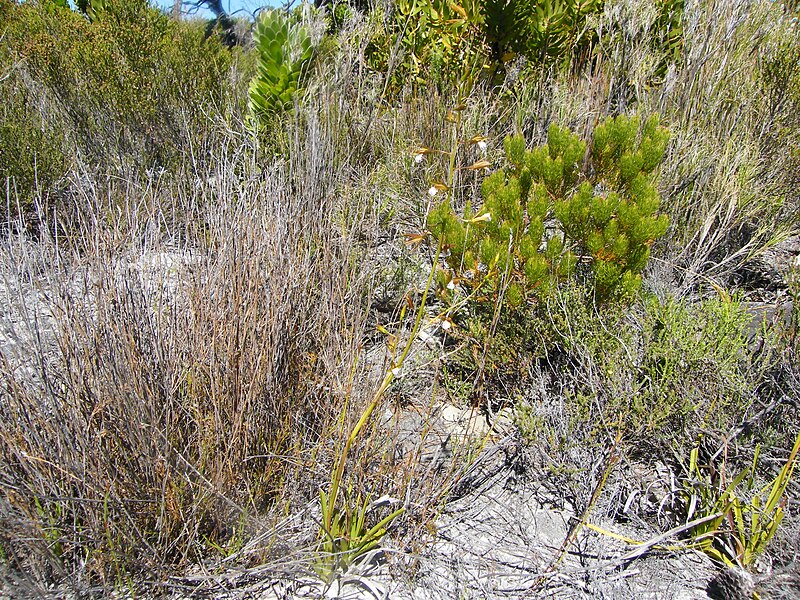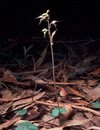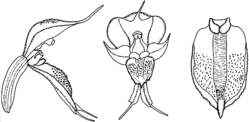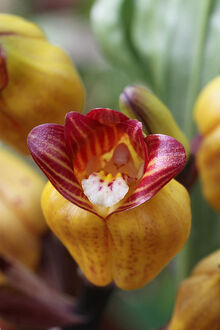Keluarga Orchidaceae
- Herbal atau jarang rambat, sangat mycotrophic, epiphytic, terestrial, lithophytic, atau jarang air atau bawah tanah, biasanya hijau dan fotosintetik, beberapa tanpa klorofil dan saprophytic.
- Akar bawah tanah atau udara, tuberoid atau stolonoid, biasanya dengan spons, velamen berlapis-lapis. Batang tegak atau belum diselesaikan atau dimodifikasi menjadi merayap rhizomes, sederhana atau sympodially atau monopodially bercabang, halus untuk gemuk, atau menebal sebagai corms atau pseudobulbs, atau sangat berkurang, kadang-kadang proliferous (terutama beragam dalam sympodial anggrek).
- Daun soliter, beberapa, atau diperkecil ke skala, basal atau cauline, alternatif, distichous, atau kadang-kadang berlawanan atau whorled, baik membelit atau menggandakan, sederhana, sessile atau petiolate; stipules absen; blade mengartikulasikan atau tidak, plicate atau conduplicate, cylindric, segitiga , atau lateral rata, margin keseluruhan.
- Inflorescences terminal atau lateral, racemes, paku-paku, malai, atau jarang cymose, tegak atau berbagai diselesaikan, 1 banyak-bunga, kendur atau padat, berbunga berturut-turut atau secara simultan. Bunga biseksual [jarang berkelamin tunggal], epigynous, resupinate atau tidak, pedicellate atau sessile, 3-merous, biasanya bilateral simetris [jarang hampir radial simetris], dengan amputasi lapisan antara pedicel dan gagang bunga, jarang antara ovarium dan ovarium dan perianth atau pedicel; perianth dari 6 tepals dalam 2 whorls, semua daun petaloid atau kadang-kadang lebih hijau dan lebih foliaceous dalam tekstur; daun sama atau tidak, daun lateral sering bawaan (membentuk synsepal), atau semua daun 3 berbagai bawaan dan / atau adnate atau berbeda dan / atau bebas; kelopak 3, rata-rata kelopak diubah seperti bibir, biasanya lebih besar atau perbedaan dalam bentuk dan warna, umumnya kelopak lateral tetapi tidak selalu sama dengan daun; nectaries berbagai macam; extrafloral nectaries kadang-kadang hadir di pedicels, bracts, atau daun sarung; benang sari biasanya 1 2 (3, jika 3 3d diubah menjadi steril staminode), semua sisi yang berlawanan di bibir, sepenuhnya atau sebagian adnate untuk gaya, membentuk kolom; serbuk sari di monads atau tetrads, biasanya dalam 2 8 pollinia, kadang-kadang dibagi ke dalam paket-paket kecil, jarang rinci , kadang-kadang pollinia dengan caudicles dan / atau stipes; gynoecium 3-carpellate, bawaan, membentuk senyawa, inferior, 1 - atau 3-locular ovarium; adnate berbagai gaya untuk filamen; putik biasanya 3-lobed, untuk cembung cekung, bagian dari stigma median lobus dimodifikasi menjadi rostellum, sering memisahkan bagian subur antera dari stigma, umumnya mencegah atau dalam beberapa kasus penyerbukan memfasilitasi diri; ovula banyak, anatropous, menit.
- Buah kapsul, pembukaan (dehiscing) oleh celah membujur, jarang berdaging dan indehiscent berry. Bibit banyak (jutaan dalam beberapa jenis), menit; endosperma absen. Genera ca. 800, spesies 22.000 35.000 (701 genera, 208 spesies dalam flora, 1 genus, 6 spesies memperkenalkan): di seluruh dunia kecuali Antartika, paling beragam di hutan tropis. Menghitung keseluruhan untuk anggrek genera flora termasuk Spathoglottis plicata Blume, yang baru-baru ini melaporkan dari Palm Beach County, Florida.
Tanaman, yang dikenal secara lokal sejak 1982, yang tampaknya luas dinaturalisasikan shellpits tua. Jumlah spesies flora baru termasuk salah satu spesies dikenali dalam morfologi Habenaria yang dijelaskan, tetapi tidak sepenuhnya diperlakukan di sini.
Orchidaceae adalah oleh jauh terbesar dan paling beragam monokotil keluarga dan peringkat di antara keluarga terbesar tanaman berbunga. Yang akurat tentang jumlah genera dan spesies telah menghindari anggrek ilmuwan, dan spesies penting diterbitkan dalam 20 tahun terakhir berkisar antara 15.000 hingga 35.000. Spesies baru terus-menerus dijelaskan. Selain itu, sejumlah alami dan buatan hibrida ada.
Meskipun anggrek yang penting dalam hortikultura, sebagian besar tanaman yang diperdagangkan di pasar nasional dan internasional termasuk sejumlah kecil spesies dan hibrida mereka hanya dalam beberapa genera; mayoritas anggrek tidak umum dibudidayakan. Beberapa anggrek secara ekonomi penting di luar perdagangan hortikultura: buah dari beberapa jenis Vanili merupakan sumber rempah-rempah vanili, dan akar kering beberapa spesies Dactylorhiza, Eulophia, dan Orchis dijadikan salep, tepung dikonsumsi di Afrika utara , Timur Tengah (khususnya Turki), dan Asia. Beberapa spesies lokal digunakan untuk tujuan pengobatan; si lendir dari pseudobulbs dari beberapa spesies kadang-kadang digunakan sebagai lem, dan di Timur Jauh yang berasal dari beberapa spesies Dendrobium dibagi menjadi strip digunakan untuk menenun kerajinan. Beberapa anggrek telah ditemukan menyebabkan dermatitis kontak (misalnya, Cypripedium reginae). Anggrek berkisar vegetatif dari tanaman kecil sekali beberapa milimeter panjang (Liparis Thouars dan Platystele Schlechter) ke cluster raksasa dengan berat beberapa ratus kilogram (Grammatophyllum Blume) untuk beberapa sebanyak 13,4 meter (DE Sobralia altissima Bennett & Christenson, yang baru saja dijelaskan spesies dari Peru).
Demikian juga, ukuran bunga bervariasi dari kurang dari 1 mm dan nyaris tak terlihat dengan mata telanjang (Platystele Garay), untuk 15 20 cm diameter (beberapa Paphiopedilum Pfitzer, Phragmipedium Rolfe, dan Lindley Cattleya spp.), Dan akhirnya menjadi 76 cm [Phragmipedium caudatum (Lindley) Rolfe]. Berat dapat bervariasi dari sepersekian gram (banyak Pleurothallus R. Brown spp.) Untuk hampir 100 gram (Coryanthes Hooker spp.). Wewangian mereka bervariasi dari yang menyenangkan (Cattleya Lindley) untuk menjijikkan dan tak tertahankan (dalam beberapa spesies Liparis Thouars). Menjajah habitat tanaman mulai dari beberapa tempat terkering dan terpanas di bumi untuk terbasah dan keren, benar-benar terjadi dari daerah kutub ke khatulistiwa.
Dalam monokotil, yang paling penting fitur diagnostik adalah pengurangan Orchidaceae adaxial benang sari, fusi dari sisa benang sari ke gynoecium membentuk kolom, agregasi serbuk sari ke pollinia kompak (sekarang di tempat lain hanya dalam dicots, di Asclepiadaceae), diferensiasi Median kelopak ke bibir, yang kadang-kadang organ kompleks, dan sangat kecil ukuran biji, yang tidak memiliki endosperma. Karakter pembeda antara lain: serbuk sari di pollinia biasanya tidak tersedia sebagai sumber nutrisi (Cleistes Richard ex Lindley menjadi pengecualian), dan yang sering interaksi dengan penyerbuk kompleks berujung pada fenomena pseudocopulation di beberapa genera (misalnya, Ophrys Linnaeus , Caladenia R. Brown sekte. Calonema, Drakaea Lindley). Dalam proses terakhir, bunga meniru penampilan, aroma, dan sering kali gerakan perempuan tawon, menarik jantan dari spesies yang cocok yang mencoba bersanggama dengan bunga. Ini biasanya hanya berhasil menjadi terpasang pada pollinium, yang kemudian akan ditransfer jika laki-laki mencoba untuk bersanggama dengan bunga lain. Akar anggrek tersebut dapat dilindungi dengan velamen, spons yang berasal dari lapisan epidermis; berdaging thickenings dari akar tuberoids (umbi dibatasi untuk batang). Mungkin batang bengkak atau menebal, corms bawah tanah atau udara pseudobulbs. Bunga sering resupinate: bibir (diubah median kelopak) yang paling bawah, biasanya sebagai akibat dari pedicel sedang memutar atau membungkuk dalam perkembangannya oleh 180 °. Pedicellate indung telur, biasanya digunakan dalam referensi untuk panjang, mengacu pada gabungan pedicel dan ovarium. Bunga tidak selalu ditanggung pada pedicels; ketika mereka, kadang-kadang sulit untuk membedakan antara yang ramping dan pedicel ovarium. Akibatnya, karena mereka ramping indung telur, bunga dari paku yg berbentuk gugusan tampak pedicellate meskipun mereka sessile, sementara spicate segugus telah pedicels begitu singkat bahwa mereka tampaknya tidak ada. Bunga anggrek sering memiliki median yang dimodifikasi sepal, sepal dorsal. Daun penggabungan tips mereka membentuk synsepal. Bagian tengah atas (adaxial) wajah dari bibir adalah disc: ini mungkin merupakan kalus menebal dan mungkin beruang rambut, papila, atau ornamen lainnya. Di anggrek gaya, stigma, filamen, dan satu atau lebih kepala putik bersatu untuk membentuk sebuah kolom; pelengkap proyeksi lateral dari stigma adalah sayap kolom; bibir mungkin harus terpasang ke tonjolan di dasar kolom untuk membentuk kaki kolom ; lateral daun yang juga melekat pada kaki membentuk mentum (dagu). Dalam kebanyakan anggrek beruang kolom tunggal pada puncaknya antera; yang clinandrium adalah rongga yang di dalamnya antera ditanggung atau tertanam. Serbuk sari ditanggung dalam diskrit massa (pollinia). Genera dengan bertepung (sectile) pollinia mungkin pollinia dalam antera lonjong menjadi ekor tepung sari (tangkai), yang melekat ke viscidium lengket. Mereka yang memiliki pollinia lilin pollinia terikat pada satu atau dua stipes (dari putik asal dan terbentuk di luar antera), yang pada gilirannya terpasang pada viscidium. Berbagai sekumpulan pollinia, caudicles, stipes, dan viscidium membentuk pollinarium, unit penyerbukan dibawa oleh penyerbuk. Stigma median lobus mungkin memiliki ekstensi atau li ramping
 HOME
HOME

















